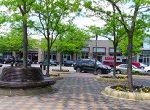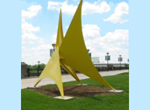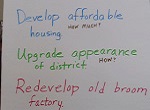Downtown Redevelopment Needs Government, Business
Last Reviewed: June 16, 2024
The downtown redevelopment process is quite similar to redevelopment anywhere in general. However, more coordination is required to deal with complex infrastructure and densification, which is just the fancy word for making the commercial and residential uses denser, meaning more square footage per acre or block, for example.
Usually the legal, financial, and logistical complications are considerably greater than those encountered further from the city center. Even experienced developers sometimes experience heartache when they do their first downtown project.

For both large and small city downtowns, we recommend the basics of the
Main Street approach.
Today's viable uses in most downtowns are office, entertainment, rental
housing, for-sale condominiums, cultural institutions, and retail that
serves residents or a very elite clientele. Sports venues are helpful in the long run only if they are multi-purpose, we think.
We did not include what is called regional retail, which was the mainstay of downtown activity during the twentieth century. As much as we would like to see that, in most places that is not realistic.
If you can draw a major discount or department store to build a multi-story building downtown in a traditional building style, we applaud you. However, it's unrealistic unless you are in a high demand market. If so, you should hire a downtown consultant to see what can be done.
Some of you weren't thinking of anything as drastic as a downtown redevelopment project, and certainly not one that promised to go on for years. But that's what it will take, friends. Even if you're the hot spot for housing, retail, or offices now, in five years suburbs or highway development will overtake a complacent downtown.
What to Do If Your Main Problem Is Vacant Storefronts
Clarifying one point, "redevelopment" usually means the buildings need to be razed, refurbished, or reconfigured in some major way beyond what could be considered maintenance or renovation. It is possible that all that needs to happen in your particular downtown is that the buildings be filled.
If your only problem is vacant commercial space, you might want to check out our rather drastic (and at least a little bit tongue-in-cheek) proposal for a vibrant downtown ordinance. The idea is to require commercial building owners to fill the first floor with something, almost anything as long as it isn't anti-social.
We also recommend the subtle or not-so-subtle nudge of a vacant building registration requirement as a financial incentive to building owners and an administrative assist for local governments trying to stay abreast of the whereabouts of property owners.
If you're in a small town, by the way, let's send you over to learn about small town character.
Mixed Use and the 24-Hour Downtown
To keep downtown redevelopment vital and interesting, definitely consider vertical mixed-use development, where apartments and condos are on the second and subsequent floors.
In the U.S. at least, retail space is seriously over-built, so not every town will realize the dream of retail on the first floor of new developments right away. If you need to fill the first floor spaces with offices, do it, but encourage or force the offices to fill the storefronts with enticing eye candy.
Emphasize the concept of street activity after 5:00 p.m. The multi-functional, 24-hour-a-day, downtown develops its own delicious rhythms, and it's simply a waste of the wide and large infrastructure to use the area only about ten hours a day.
When we speak of 24 hours a day for downtown, it's simply another way of restating the importance of developing or returning to some residential uses.
Try to assure that a mix of incomes can live downtown, and we don't mean you should do that by retaining substandard housing. You'll want a mix of ages in your downtown redevelopment, and in practice that means you can't develop all luxury condos that are unaffordable to the young.
The young, in case you haven't noticed lately, are the ones out clubbing till 1:00 a.m.
You also might need to think of subsidizing particular local retail uses, most typically a grocery store for large city downtowns, as the housing market develops and strengthens.
Green space or plaza areas for gatherings also are important to downtown redevelopment.
Even the smallest downtown needs a few places for benches other than along the sidewalk. In tiny towns, these green places can become a unifying community project honoring local history, a past popular leader, or a local feature or product.
Enliven an existing green space or public space with some whimsical public art or a landscaping facelift.
I'd even like to see some free or nearly free indoor gathering spaces available to community groups within a downtown area. Since most downtowns have plenty of empty space if you poke around, it's not as far-fetched as it might seem.
With today's video surveillance technology, electronic keys, and potential to use the Internet as a reservation system, it's not as much of a hassle as you might think. And you can charge a hefty deposit, in case of damage or abuse.
If your downtown includes one-way streets, you may want to consider that the trend is away from one-way streets and toward two-way. Half the traffic should equal half the shoppers or diners on the street, right?
Land Uses to Avoid in Downtown
Perhaps the hardest part about downtown redevelopment is being ruthless about putting the right types of businesses in the downtown, and weeding out anything that does not belong there.
What shouldn't be downtown? Anything that presents a long blank wall or long ugly parking lot to the pedestrian does not belong in a healthy downtown. It doesn't matter whether that empty wall is your public library, a printing plant, or a city hall. It still doesn't entice me to keep walking. Large parking lots are even worse. See our answer to one of our site visitors who asked about too many parking lots in big city downtowns.
Even the banks need to be challenged to make their windows and faces interesting. Churches need to be asked to join the downtown redevelopment program; often their entrances above street level break the pedestrian flow. Some will accommodate you with a garden, attractive benches, or a labyrinth in front.
If the blank walls are unavoidable, the fix is to see if the front of the building (facade) can be modified to accommodate changing exhibits, interesting art, or some other attractive landscape or water feature to keep the pedestrian's juices flowing.
In a slightly more practical vein, you could paint on some faux windows, doors, window boxes, building ornaments, and so forth.
Another important point is to eliminate or bridge anything that presents a hazard to a pedestrian, such as impenetrable freeways, huge wide streets with tiny narrow sidewalks, and three or four contiguous lanes of parking garage entrance and exit.
In smaller cities and towns, there are many hazards as well. For instance, watch out for the parking lot exit that's out of view of the pedestrian until they round the corner.
Parking for all but the two-block long downtowns needs to be behind the buildings. I know the merchants will howl; I've been there.
But surface parking is just dull-looking. If you have a surface parking lot that the locals won't give up, at least spiff it up with colorful landscaping on the side nearest the sidewalk. But of course that doesn't entirely compensate for the problem, as you'll need to leave some sight distance for traffic to exit safely.
A courtyard effect, in which parking is located in the center of several streets of downtown businesses, is pleasant and effective. The parking garage might be acceptable in this configuration even if people wouldn't consider it otherwise. Tuck employee parking somewhere on the periphery, however.
Expect parking to be a magnet for discontent with downtown redevelopment. It's what I call the Law of the Small Fish. People get very agitated about minor matters in order to avoid dealing with important but confounding questions.
We expect some of these parking problems or perceived problems to be remedied gradually as driverless cars gain prominence. In place of parking, you can expect new little dramas about curbside dropoff spaces. To ponder how autonomous vehicles might impact your downtown, see our page about driverless cars and city planning. Then as you plan your redevelopment strategy, keep one eye on possible lesser needs for parking as ridesharing and driverless vehicles gain even more traction.
Another thing that doesn't belong downtown is people problems. If you have obvious homelessness, some community mental health issues visible during the day, squatters, or panhandling, that really detracts from the perceived safe atmosphere that needs to form the blank canvas on which all of your exciting activities and attractions will be painted.
The last thing that should be downtown is a junky vacant lot. Actually you should plan toward having zero vacant lots period, but while you are waiting for that to become a practical suggestion, plan a major push to clean up any lots. One site visitor described a fairly simple downtown vacant lot clean up initiative.
Tackle those things; all these people issues need to be resolved anyway, don't you agree? Don't just shoo them away; do something about the problem.
Organizing for Downtown Redevelopment
So for downtown redevelopment, develop a very strong public-private partnership with a robust organization targeted just to downtown.
Establish downtown boundaries, and do a SWOT analysis and then a strategic plan that explains desired downtown character in pictures, diagrams, and words.
I can write about the need for a downtown plan in one sentence, but expect that a quality plan, whether you do it yourselves or with a consultant or facilitator, will require 12-18 months to get it right. Downtown redevelopment or revitalization plans can serve as an inspirational call to action, a record of public conversations and discussions, a data snapshot in time, a pattern book for architects and designers, and a way to formalize agreements about what the business community and the city each have agreed to do. It also may provide a road map for any needed rezonings.
Downtown needs a manager. Yes, you need a person to market the area, to think up exciting seasonal special events and promotions, coordinate advertising, keep your area in front of multiple audiences through social media, make sure that the place is clean as a whistle, landscape and beautify, and do away with senseless visual clutter while promoting just the right amount of keen visual interest.
The manager should have some relevant experience; don't just hire a marketing maven. This manager needs a good eye for urban design, as common awning, sign, streetscape, and wayfinding systems may need to be part of his or her job description. Some real estate smarts are essential too.
As we imply here, you need to give this downtown manager a lot of clout when it comes to the exterior of the buildings, as well as the general types of businesses.
Smaller city and suburban downtowns often resist organizing, even when it's in their best interests to do so. Newer suburbs that have manufactured or retained some semblance of a downtown may have done so mostly through the use of franchise stores, and some of those owners don't have much vested interest in the locality.
When the tradition of local ownership and active participation in the business is strong, however, the problem is the opposite. These owners are fiercely independent and don't necessarily see the benefit in cooperating for the common good.
So you have to take an individualized approach to convincing downtown players to participate in the downtown redevelopment partnership and its activities.
Downtown Incentives and Disincentives
A key policy question that can be answered only through the joint planning process of the public-private partnership is whether the approach toward moving property and business owners along the desired path should be the carrot or the stick.
In areas where the government has a strong track record of leadership and where the market is generally strong as well, a regulatory approach may well be warranted.
This could include code enforcement to make sure the exteriors of buildings are well maintained, architectural controls, and imposing of additional taxes if permitted in your state. Some governments have prepared strong downtown plans and then proceeded to implement them, even using eminent domain (condemnation) where necessary to force property owners into line.
If the market is soft and there's extensive competition from other towns and suburbs, however, you may want to provide a menu of incentives, up to and including tax increment financing, for example.
Many states allow business districts to tax themselves for the betterment of the district. If this is permitted in your state, downtown is a prime candidate for this treatment.
Business improvement districts and special business districts are the most common names for this mechanism. The steady source of dedicated income can increase the likelihood that your downtown redevelopment plan will be implemented.
Certainly streetscape programs are frequently used to spur downtown redevelopment. But they're only effective if combined with a variety of other tactics. When traditional methods are failing, an increasing number of city centers are opting to try an arts strategy, particularly if they already have an arts anchor institution or are located near a university campus.
Some municipalities seem to think these programs are magic, and somehow if you build it, they will come. Not necessarily. Pedestrian comfort, demand for state-of-the-art office space, and an exciting array of entertainment and shopping experiences will be much more important.
If your existing sidewalks are in good repair and you have some minimal opportunities to sit and to take shelter from the elements, your investment may be much better placed in management, promotion, street cleaning, planting annuals, and property and business owner education.
Continuous Improvement for Your City Center
Just when you think you're finished with downtown, there's another sea change in consumer habits, lifestyle preferences, and economic conditions. So you're never really out of the business of downtown management.
If you want to dig deeper into revitalizing downtown, we find this article by Christopher Leinberger to be useful. Past research at University of Wisconsin Extension showed no single factor determining the success of downtown, so take courage if it is not practical for your downtown to meet every criterion cited by an urban affairs expert.
Please share your downtown's success or failure stories with us on the community development questions or stories part of this website. For further reading, you may need to check out some of our pages below. The first two relate to beautification, which might be a vital part of your redevelopment program. Then we suggest both setting up a CDC and getting tough on building owners who leave their spaces vacant in the hope of attracting a higher rent. Many other topics reached from the menu or search bar also may be applicable to your particular situation.
- Making and Keeping a Good Community >
- Community Challenges, Common Topics & Concepts >
- Redevelopment > Downtown Redevelopment
Join GOOD COMMUNITY PLUS, which provides you monthly with short features or tips about timely topics for neighborhoods, towns and cities, community organizations, and rural or small town environments. Unsubscribe any time. Give it a try.




